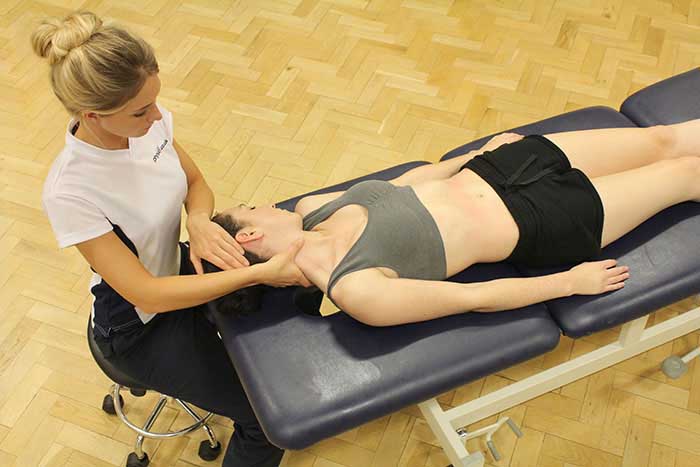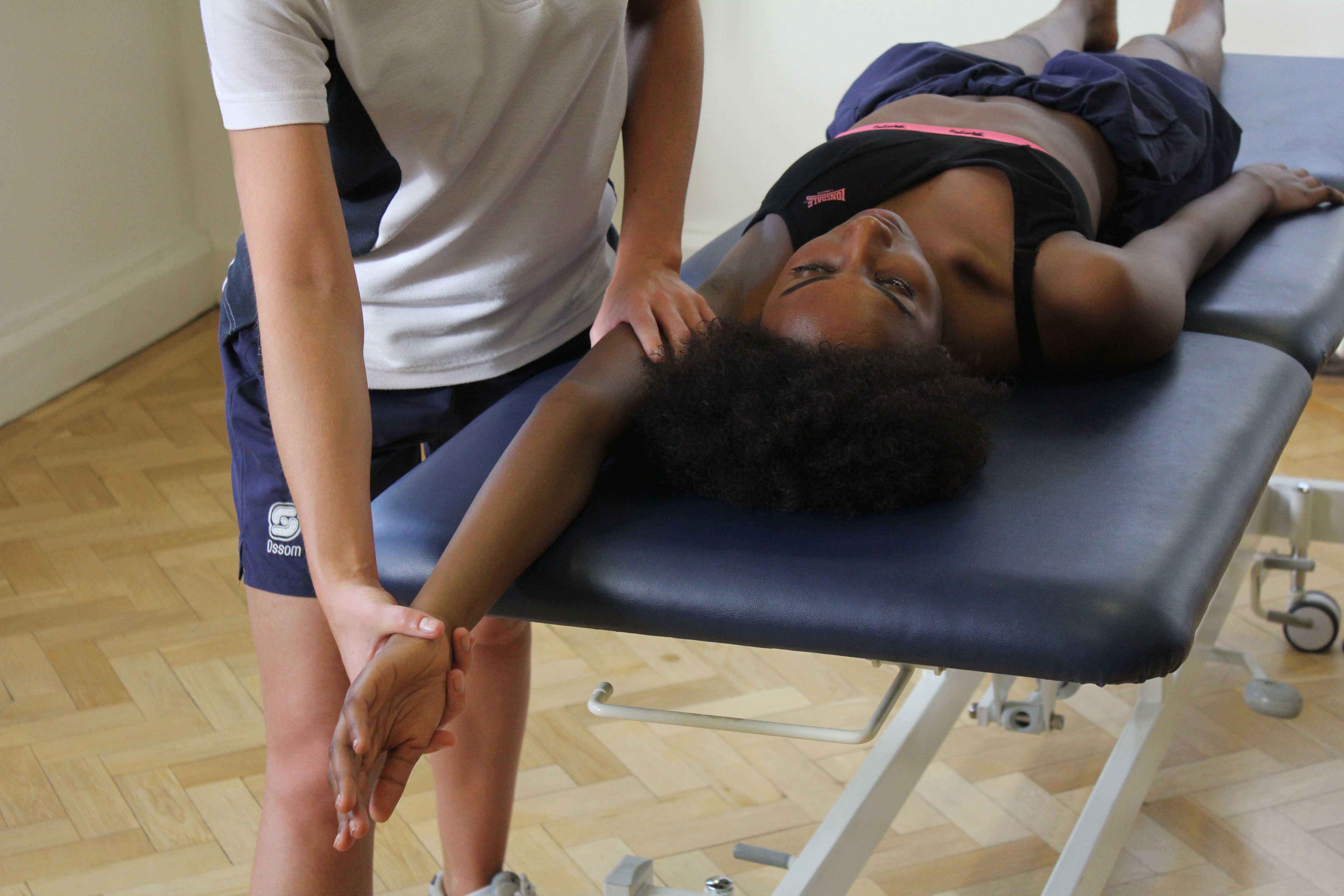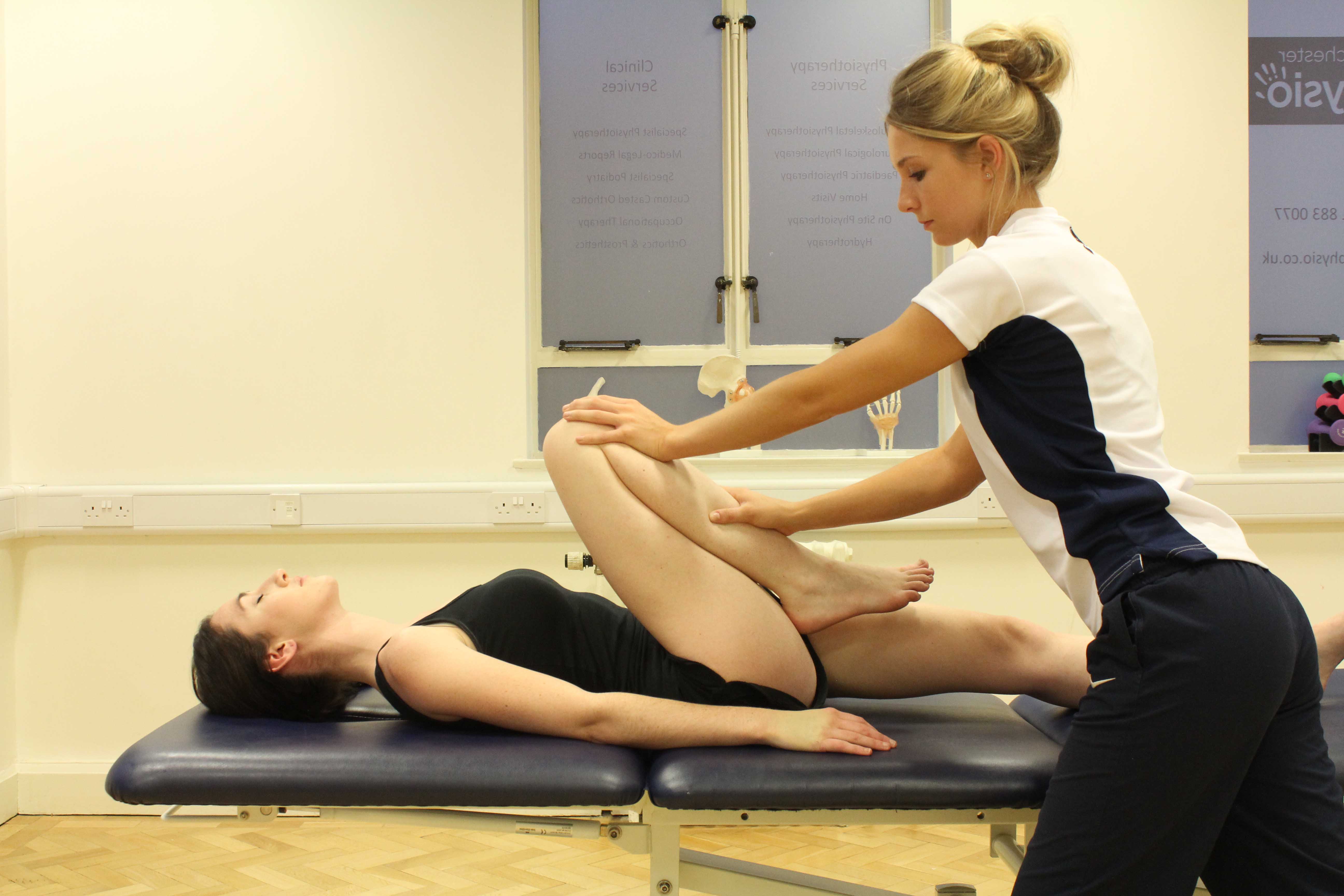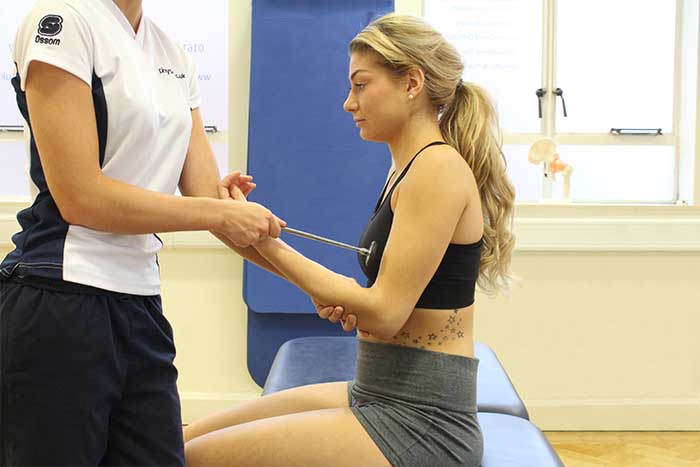Tight muscles can often be helped through massage. Tight muscles are very common in a variety of people. There are many causes of tight muscles, the most common causes being overuse, poor posture and injury. Tight muscles can cause restriction in movement resulting in pain, stress and increased chances of injury during activity. Our massage therapists at Physio.co.uk use massage to relieve tight muscles to help increase movement, decrease pain and increase relaxation.
What type of massage is used for tight muscles?
There are a variety of massage types that can be used to help treat tight muscles. The most common types of massage used include:

When can massage help tight muscles?
A massage for tight muscles can help in many ways. The most common ways massage can help tight muscle include:
 Above: Massage and stretch of glenohumeral joint to ease tight muscles
Above: Massage and stretch of glenohumeral joint to ease tight musclesDelayed onset muscle soreness can be helped through massage for tight muscles. Delayed onset muscle soreness can occur between 24 and 72 hours after intense exercise or activity. Delayed onset muscle soreness can be caused by overuse of muscles or insufficient warm up or cool down. One factor of delayed onset muscle soreness is muscle tightness. Muscle tightness increases pain, reduces movement and can increase chances of injury. A massage can help to reduce muscle tightness by increasing muscle temperature resulting in an improvement in tissue elasticity. Increasing tissue elasticity reduces restricted movement and allows the muscle to relax. Relaxation of muscles decreases pain and reduces chances of injury. Reducing pain and increasing relaxation helps to decrease delayed onset muscle soreness.
A massage for tight muscles can help pre event. Before an event, muscles can often be tight due to an increase in training to prepare for the event. Muscle tightness restricts movements and makes injuries such as muscle strains, pulls and tears more likely to occur. A massage aims to decrease muscle tightness by increasing muscle flexibility and elasticity through rising the temperature of muscle fibres and tissues. Increasing flexibility and elasticity of a muscle allows full range of movement with no restriction or pain. Allowing full range of movement decreases chances of injury during the event and therefore helps a person to prepare beforehand.
Relaxation can be increased through massage for tight muscles. When muscles are tight, movements are often restricted making normal everyday activities difficult. Movement is restricted due to an increase in pain and an incapability of stretching a muscle to its full length. Restricted movement and an increase in pain that occurs as a result of tight muscles, decreases relaxation and increases stress and frustration. A massage aims to reduce muscle tightness by increasing muscle temperature. An increase in muscle temperature occurs due to the encouragement of improved blood flow to the treatment area. Increasing muscle temperature decreases tissue inelasticity and allows muscle relaxation. Allowing muscle relaxation reduces muscle tightness. Decreasing muscle tightness provides the capability of a muscle to stretch to its full length with no restriction or pain. Allowing full movement with no pain reduces stress and frustration therefore increasing relaxation.
What are the physiological effects of receiving a massage for tight muscles?
A range of physiological effects occur during a massage to help tight muscles. The physiological effects that most commonly occur include:
 Above: Massage and stretch of acetabular joint to ease tight hip muscles
Above: Massage and stretch of acetabular joint to ease tight hip musclesIncreased temperature through massage can help relieve tight muscles. Increased temperature involves all muscular, fascia deep and superficial tissues rising in temperature. Temperature is increased through an increase in blood flow that occurs due to friction created between the skin and fingers. Increased temperature is useful to improve tissue elasticity, flexibility and range of movement. Increasing the elasticity, flexibility and range of movement within muscles helps to decrease muscle tightness.
An increase in tissue elasticity can help treat tight muscles. Tissue elasticity is the ability of a muscle to stretch to its full length without any feelings of restriction or pain. When tissue elasticity is poor, muscle tightness increases, reducing movement, increasing pain and rising stress levels. Poor tissue elasticity can also result in injury during exercise or an event. A massage aims to increase tissue elasticity through a rise in muscle temperature. Increasing tissue elasticity improves the range of movement, decreases restriction and relieves pain. Relieving restriction and increasing the range of movement contribute to a decrease in muscle tightness.
A physiological effect of massage for tight muscles is the breakdown and realignment of collagen fibres. Collagen fibres are tough and fibrous and are often formed to help repair damaged muscle tissues or fibres. Collagen fibres can form in bundles creating an adhesion. An adhesion lays haphazardly along a muscle fibre and aims to repair any damage. The haphazard position adhesions are lay in causes the muscles natural movements to be reduced, increasing muscle tightness. A massage helps to break down adhesions by increasing the temperature of collagen fibres. Once the collagen fibres are broken down, various long, deep massage strokes are used to realign the collagen fibres to lay in the same position as the body's natural muscle fibres. Realigning the collagen fibres helps to increase movement and therefore decrease muscle tightness.

What are the benefits of receiving a massage for tight muscles?
Various benefits can be gained through massage for tight muscles. The most common benefits gained include:
Maximised performance is a common benefit of massage for tight muscles. When muscles are tight, full movement is prevented. Prevention of full movement can lower performance. Muscle tightness can also lower performance due to the increased chance of injury. A person can have a feeling of fear or anxiety during their event if they know they are likely to become injured by over exerting their muscles. A decrease in muscle tightness relieves restriction and reduces the chances of injury. Reliving restriction allows full movement, helping to maximise performance. The reduced chance of injury can also maximise performance as feelings of fear or anxiety during the event will decrease.
Relieving tight muscles through massage can increase a person's range of movement. Muscle tightness decreases a muscle's capability of reaching its full length with no restriction or pain. Poor range of movement can increase stress and prevent a person from taking part in exercise or activity or in their regular daily routines. Relief of muscle tightness allows muscles to relax and stretch. Increasing relaxation of muscles and allowing muscles to stretch, increases their capability of reaching its full length. Allowing a muscle to reach its full length, increases range of movement as well as decreasing stress and the prevention of injury during exercise and activity.
A benefit of massage for tight muscles is improved posture. Muscle tightness is often a cause of poor posture. The most common type of posture seen in many different people is where their shoulders are brought forward causing an arch in the upper back. This kind of posture is often termed as "kyphotic". A kyphotic posture can increase pain, weaken muscles and lead to further muscle tightness. Relieving muscle tightness through massage allows a posture to reset and return to normal without any restriction. Resetting a person's posture can strengthen weakened muscles, increase range of movement and decrease pain.
Summary
A massage for tight muscles involves the use of a variety of massage techniques including effleurage and deep strokes, in order to relieve tension and relax restrictive muscle fibres. There are a wide range of massage types that can be used for tight muscles including sports massage, deep tissue massage and remedial massage. A massage for tight muscles can help a person with delayed onset muscle soreness before they take part in an event and increase relaxation. There are various physiological effects of massage for tight muscles including increased temperature, increased tissue elasticity and the breakdown/realignment of collagen fibres. Benefits of a massage for tight muscles include maximised performance, increased range of movement and improved posture. Our therapists at Physio.co.uk use massage for tight muscle to help reduce chances of injury and decrease stress.
How can I arrange a massage for tight muscles?
The easiest way to arrange a massage for tight muscles at Physio.co.uk is to email us at office@physio.co.uk or call us on 0800 033 7800.
You can also book an appointment online and save £10

 0330 088 7800
0330 088 7800






































